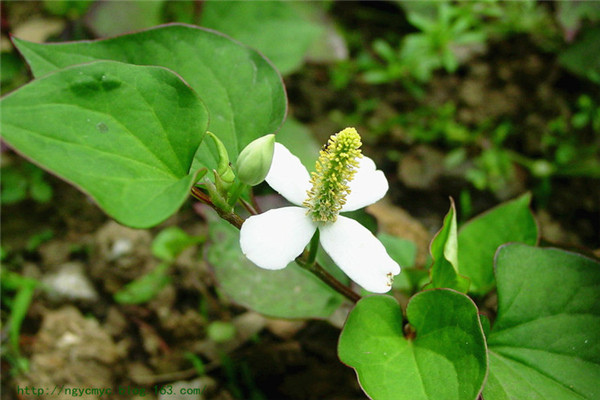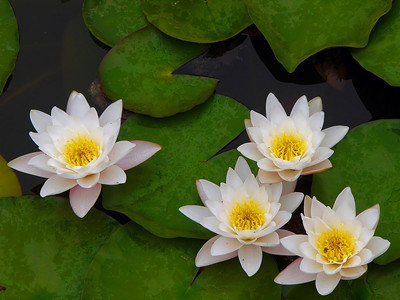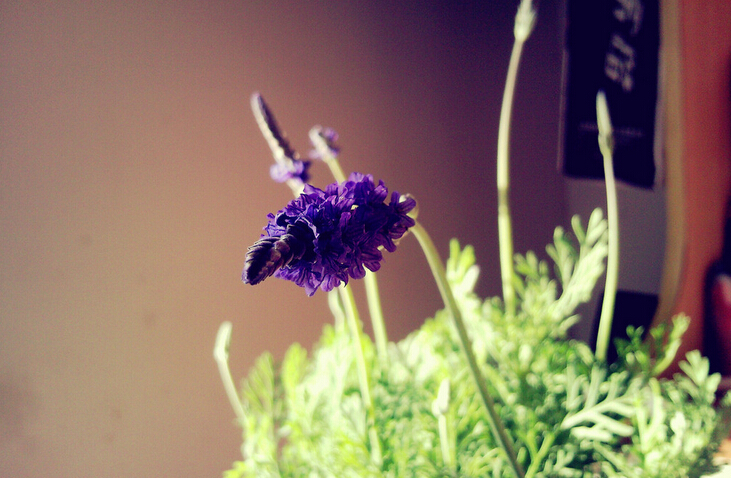Culture methods and matters needing attention of Houttuynia cordata Thunb
Seed germination rate is not high, germination is suitable for 17-25 degrees Celsius temperature change, germination rate is about 20%. It can be propagated by ramet, cuttage and rhizome. Ramet propagation is from late March to April, and the mother plant can be dug up and transplanted on the seedbed of sandy soil or directly transplanted. Cuttings can be propagated in spring and summer, cutting sturdy branches without disease and insect pests as cuttings, cutting and growing at least three knots, cutting on the seedbed of sandy loam with a row distance of 16 × 10 cm or 14 × 10 cm. Watering after insertion, shading, rooting and transplanting seedlings. Rhizome propagation can be carried out from February to March. Excellent white and sturdy rhizomes are dug and cut into small segments with more than 2 axillary buds. Shallow trenches are opened on the seedling bed or in the field to raise seedlings or plant.
Land preparation and planting
Select sandy loam with loose fertilizer, convenient drainage and irrigation, leeward and sunny soil or soil rich in organic matter for cultivation. After deep ploughing and loosening the soil, the border will be 1.5 mi 1.6 meters wide, 30 cm high and 20 cm wide at the bottom of the ditch. Apply farm soil fertilizer 3000mur4000 kg per mu as base fertilizer, open shallow ditches or dig holes according to plant spacing of 14 × 20 cm, and water after planting to keep the soil moist.
Field management
In case of drought in the seedling stage, it should be watered sooner or later to moisten the border soil. Before the seedlings survived, weeding and topdressing were ploughed and topdressing for 3 times, and the fertilizers were mainly nitrogen fertilizers such as human feces, urine or chemical fertilizers. Each time weeding combined with topdressing, per mu of human feces and urine 1000ml 1500 kg or urea 15ml 25kg, dilute and then dense application. Nitrogen fertilizer is mainly applied after harvest every year to promote plant germination; the second time is to apply phosphorus and potassium fertilizer and cultivate soil to survive the winter so as to lay a good foundation for sprouting in the coming year.
Harvest plus sweet potato
The tender houttuynia cordata was harvested from March to May for consumption. If it is mainly used for medicinal purposes, it can only be harvested once in the planting year, and can be harvested from September to October, and twice in the summer year, the first time is in June and the second time is from September to October. If you add rice to make drinks, according to the requirements of production skills, cut the whole grass flat with a sickle, wash it and dry it, and then collect it and set it aside.

Cultivation methods of Houttuynia cordata Thunb
Select sandy loam with loose fertilizer, convenient drainage and irrigation, leeward and sunny soil or soil rich in organic matter for cultivation. After deeply ploughing and loosening the soil, the border will be 1.5 mi 1.6 meters wide, 30 cm high and 20 cm wide at the bottom of the ditch. Farm soil miscellaneous fertilizer 3000ml / mu was applied as base fertilizer, shallow trenches or holes were dug according to plant spacing of 14 × 20cm, and watered after planting to keep the soil moist.
Administration and Management
In case of drought in the seedling stage, it should be watered sooner or later. Before the seedlings survived, weeding and topdressing were ploughed and topdressing for 3 times, and the fertilizers were mainly nitrogen fertilizers such as human feces, urine or chemical fertilizers.
Each time weeding combined with topdressing, 1000 kg per mu of human feces and urine or 25 kg of urea, dilute at first and then concentrated.
Nitrogen fertilizer is mainly applied after harvest every year to promote plant germination; the second time is to apply phosphorus and potassium fertilizer and cultivate soil to survive the winter so as to lay a good foundation for germination in the coming year.
Harvest and processing
The tender houttuynia cordata was harvested from March to May for consumption. If it is mainly used for medicinal purposes, it can only be harvested once in the same year, and it can be harvested from September to October. It can be harvested twice in the second year, the first in June and the second from September to October.
If the beverage is processed, the whole grass can be cut flat with a sickle, washed and dried, according to the requirements of the production process.
Propagation method of Houttuynia cordata Thunb
The seed germination rate of Houttuynia cordata is not high, the germination is suitable for 17-25 ℃, and the germination rate is about 20%, so ramet, cuttings and rhizomes are often used to propagate. In addition, Houttuynia cordata Thunb is rarely planted by families, and most of them are propagated in large numbers.
Ramet propagation
From late March to April, the ramet of the mother plant can be dug up and transplanted on the seedbed of sandy soil or directly transplanted.
Cuttings propagation
In spring and summer, sturdy branches without disease and insect pests can be cut as cuttings, cut and grow 125cm, at least three nodes, cuttings on the seedbed of sandy loam, with a row spacing of 16 × 10 cm or 14 × 10 cm. Watering after insertion, shading, rooting and transplanting seedlings.
Rhizome propagation
Can be carried out in February to March, dig excellent white, stout rhizome, cut into small segments with more than 2 axillary buds, in the seedling bed or field open shallow trench seedlings or planting.
Methods and matters needing attention in Houttuynia cordata culture
Houttuynia cordata Thunb prefers warm and humid climate. Grow well under wet and shady conditions, avoid drought, fertile sandy loam and humus loam are better when planting, and should not be planted on clay or alkaline soil.
Growth habits and environmental requirements of Houttuynia cordata Thunb.
The main results are as follows: 1. Under natural conditions, it is often wild in the grass on the edge of shady mountain, forest edge and ditch depression. Sex likes warm and humid climate, grows well in shady and humid conditions, avoids drought, adapts to a wide range of temperature, and the underground stem overwinters.
2. It will not freeze to death at-10: 0 ℃. The underground stem can grow and emerge at 12 ℃. It requires 16: 20 ℃ in the early growth stage and 20: 25 ℃ in the mature stage of the underground stem. Houttuynia cordata Thunb likes to be waterlogged and requires soil moisture, and the field soil water capacity is 75% to 80%. The soil is slightly sour, pH 6-7, and the requirements for the soil are not strict. The fertile sandy loam and humus loam are the best, but the clayey soil can also grow. Fertilization is mainly nitrogen fertilizer, proper application of phosphorus and potassium fertilizer, under the condition of sufficient organic matter, the underground stem grows sturdily.
Culture methods of Houttuynia cordata Thunb.
1. Land selection: land with loose and fertile soil and convenient drainage and irrigation, such as rice fields, ploughing and drying fields in winter, applying 2000-4000 kg of rotten organic fertilizer per 667 square meters, 25 kg compound fertilizer, crushing and leveling, border width 1.3-1.5 meters, height 30 cm, length depending on topography, ditch distance 30-40 cm, planting on the border surface.
2. Planting: Houttuynia cordata Thunb can be propagated by seeds, but it can be propagated by dividing roots. It can be planted in spring and autumn, but it is better in spring. Planting method can use hole or strip seed, apply organic fertilizer into the hole or ditch, cover fine soil 2cm, choose disease-free, sturdy underground stem cut into 4cm short segment, each section has 2cm 3 nodes, flat in the planting hole or ditch, plant spacing 5cm 8cm, and then cover soil thickness about 5cm 6cm, if the soil is dry, you can spray fixed root water to keep the soil moist.
3. Fertilization: the main fertilizer for Houttuynia cordata Thunb is nitrogen and potassium, and the amount of phosphorus is less, but it can not be lacking. When the unearthed seedlings are about 3 cm high, they can be fertilized for the first time, and a mature human feces and urine mixed with water and urea with 2% manure can be used. In the middle and later stages of production, the need for fertilizer is also relatively increased. On the basis of ensuring nitrogen fertilizer, combined application of phosphorus and potash fertilizer, especially potash fertilizer, is particularly important for the formation of roots.
4. Field management: Houttuynia cordata production should be combined with fertilization to carry out intermediate ploughing and weeding, field management should be strengthened in the middle and later stage, soil should be kept moist during the whole growing period, water should be watered in time during drought, stagnant water should be eliminated in time in rainy season, weeding, loosening soil, and promoting the combination of control and control before closing, when the aboveground disciples are long, tender stems and leaves should be picked in time; aboveground stems and leaves should be yellowed, stems and leaves should be small, appropriate topdressing should be applied to promote growth. If the plant is not reserved, the buds should be removed in time so as not to consume a lot of nutrients in flowering.
Pest control of Houttuynia cordata Thunb.
1. Diseases: Houttuynia cordata stems and leaves have fishy smell, few insect pests, and diseases include white silk disease, leaf spot disease and so on.
2. Control methods: ① chooses reasonable rotation, flood and drought rotation is better; ② chooses loose and fertile soil with convenient drainage and irrigation; ③ strictly selects seeds and removes diseased stems. ④ should strengthen field management, pay attention to drainage in rainy season and irrigation in drought; mancozeb, chlorothalonil and topiramate were selected to spray or irrigate roots in the early stage of ⑤.
Houttuynia cordata harvested:
Houttuynia cordata Thunb can be picked and eaten throughout the year, tender stems and leaves are picked in spring and summer, and underground stems are excavated in autumn and winter. The cultivated Houttuynia cordata Thunb can harvest tender stems and leaves for 2 or 3 times. One week after each harvest, it can be diluted human feces and urine or biogas slurry plus an appropriate amount of nitrogen, phosphorus and potassium compound fertilizer. A part of the underground stem is left or decapitated when the underground stem is harvested, and when the temperature rises in the next year, it will germinate and emerge, and the management of pulling grass, loosening the soil, seedling, topdressing and so on will be carried out in time, so that it can be produced continuously for many years.
- Prev

Cultivation and management of water lilies
Beautiful water lilies can be planted not only in ponds but also in pots. Pond planting should clean the pond water in early spring, apply base fertilizer and then add new pond mud and then irrigate. Irrigation should be filled many times. With the gradual addition of water to the growth of new leaves, the water depth can be kept at 70-80 cm during the flowering season. More water should be irrigated in winter
- Next

The pruning method of lavender
Lavender flowers are the most abundant in essential oil, and flowers or inflorescences are mainly used. In order to facilitate harvest, some small inflorescences at the initial stage of cultivation might as well be leveled with large scissors, and the new inflorescences are high, which is beneficial to the second harvest. Some varieties can reach a height of 90 centimeters
Related
- Fuxing push coffee new agricultural production and marketing class: lack of small-scale processing plants
- Jujube rice field leisure farm deep ploughing Yilan for five years to create a space for organic food and play
- Nongyu Farm-A trial of organic papaya for brave women with advanced technology
- Four points for attention in the prevention and control of diseases and insect pests of edible fungi
- How to add nutrient solution to Edible Fungi
- Is there any good way to control edible fungus mites?
- Open Inoculation Technology of Edible Fungi
- Is there any clever way to use fertilizer for edible fungus in winter?
- What agents are used to kill the pathogens of edible fungi in the mushroom shed?
- Rapid drying of Edible Fungi

